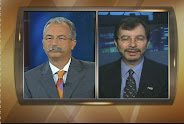Confidence, Complacency, Concern, Denial, Capitulation.
History teaches that bull markets go through five distinct phases: Confidence begins to build, invincibility then becomes the norm (Complacency sets in), Concern enters the scene (from time to time, typically when market corrections occur), then comes the Denial phase (as stocks foretell bad times ahead, which some might say creates a self fulfilling prophecy), and, finally, Capitulation - happy days are no longer here to stay (unless you are a perma bear).
Needless to say, these market phases do not have to be sequential. For example, markets may oscillate back and forth between complacency and concern.
So, where are we right now? I would say we are firmly in the complacency phase (with just a tinge of concern).
As I wrote in my blog last Wednesday, complacency about the bull has given way to complacency about the correction. The nice, neat, and tidy 10% correction.
All one has to do is watch and listen to see and hear comment after comment from the vast majority of professional investors and market strategists to hear the calming refrain, “it’s just a correction”. And it isn’t just the words, but the tone that comes across. Sanguine, to the last. Moreover, when you consider that correction analysis is more the stuff of technical analysis, at times it seems that most everyone has become a market technician. Yet, this has more to do than just technical analysis. It has to do with the fundamental driver of the current high levels of complacency – comfort with risk.
Risk measures are easy to find. In addition to investor sentiment surveys, credit spreads are also an excellent example.
While the recent market correction has widened credit spreads a tad, the following chart (see report) provides some sense of just how much further spreads have to widen before some semblance of normal, healthy risk aversion reasserts itself.
In particular, what should concern investors is how narrow the spread between emerging market and high quality debt is. It seems apparent that a belief in the emerging markets story has gotten way ahead of itself, distorting values, and providing even more liquidity to a world awash in capital.
Investment Strategy Implications
Every investor, including those unabashed fundamental types, will admit that investor psychology matters quite a bit. It is, therefore, useful to have some sense as to where we are in a market cycle. Since we are still in a bull market (having yet to form a market top), the likelihood that the current correction is anything more than that is to possess a perception of matters economic and financial that borders on the divine.
Yes, we are in a correction. But the “just a correction” mantra is just a little too complacent a term.
My view is that the correction will likely end as it did in the last correction (last summer) with concern overwhelming complacency. I don’t believe we have reached that point.
If risk spreads were to widen and investor sentiment were more bearish, then concern (and doubt) might dominate investor thinking. Perhaps, 1Q07 earnings disappointments will be the catalyst to take the market to new correction lows. And, that may be all it takes to move investor sentiment from complacency to concern.
Note: To download the complete report, please use the Blue Marble Research services link to the left.




















